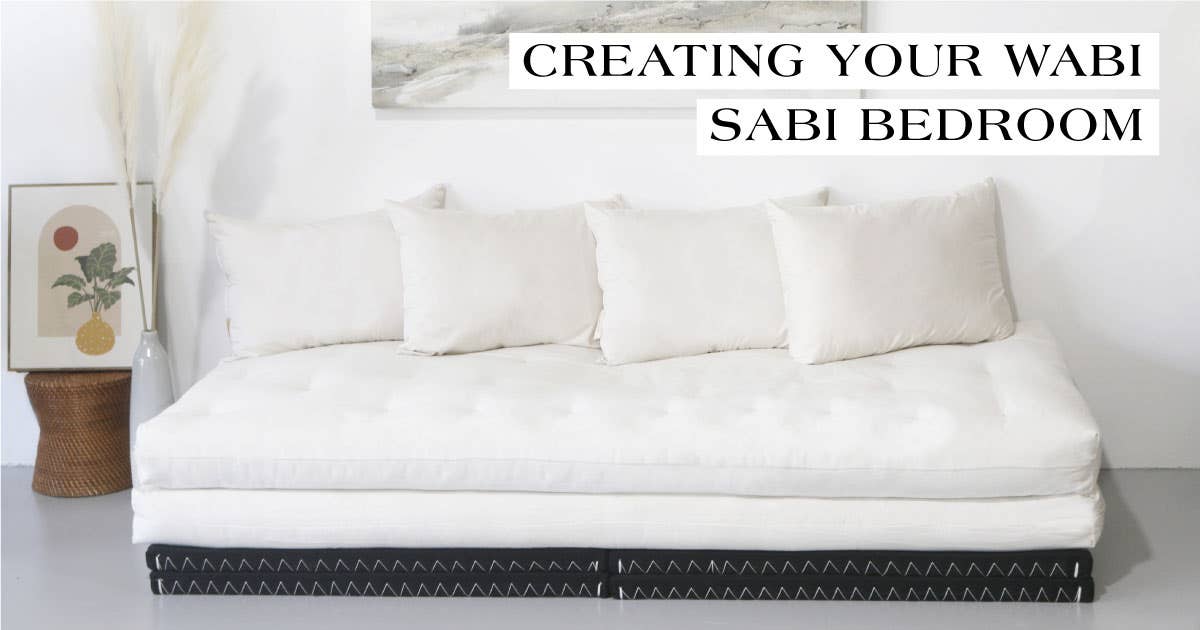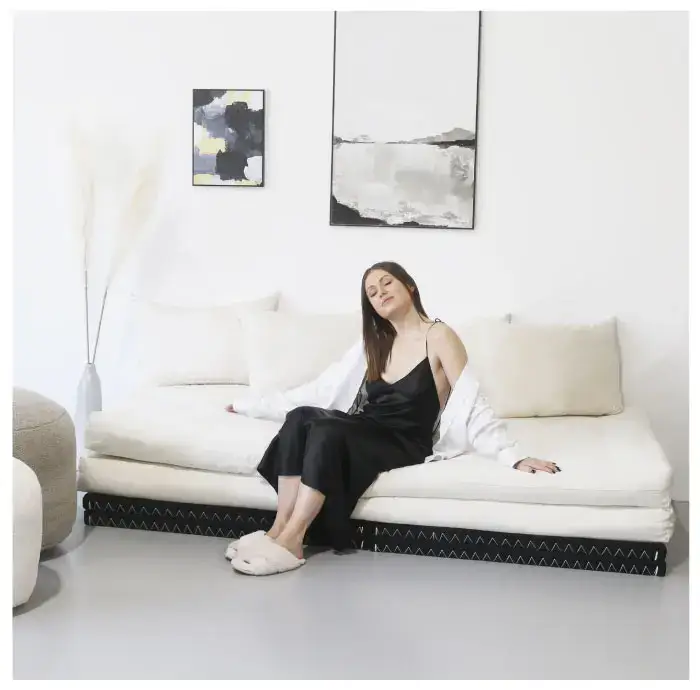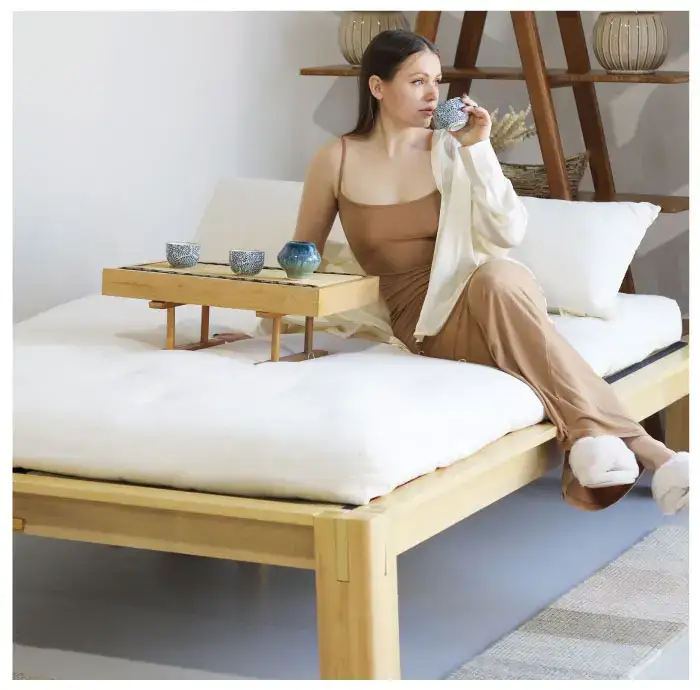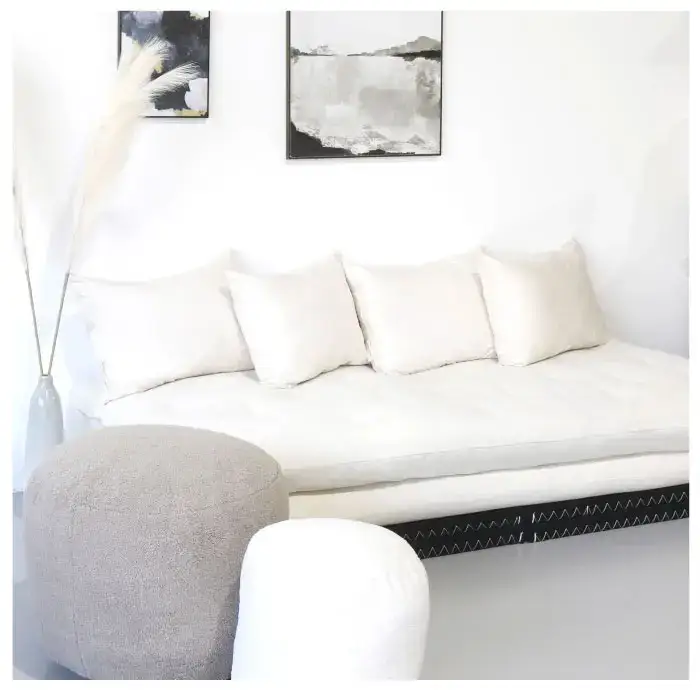
Embracing a minimalist bedroom designed with a Wabi Sabi Design includes aesthetics with Japanese furniture like a Japanese floor futon mattress. A folding futon mattress is both reliable and space saving. Futons are made from natural materials like wool, cotton and latex with zero chemicals or processing. If you're looking to create a minimalist bedroom and maximize your living space, a futon for floor sleeping is an excellent choice! With its stylish design and cozy comfort, this remarkable piece of furniture will help bring the best out of any small area. It can make your room look sophisticated while not creating too much clutter; making rooms feel less cluttered and still making room for more! With a Japanese futon floor bed, you can fold it into a sofa when guests come over or spread it out in your bedroom - the choice is entirely yours.
All About Creating A Minimalist Bedroom And Common Questions
How do I make my bedroom look minimalist?
If you're looking to make your bedroom more minimalist, it's important to start by taking a good look at everything in the room. One helpful tip to keep in mind is that for every new item you bring in, try to get rid of something you already own. This helps keep clutter at bay and ensures that you're only keeping things that are essential and add value to the space. Additionally, think about upgrading to higher quality versions of items, but don't feel the need to hold onto old things "just in case." By following these guidelines, you'll be well on your way to creating a more pared-down and peaceful sleeping space.
What should be in a minimalist room?
When it comes to creating a minimalist room, it's important to focus on the basics. The bed, bedside table, and light source are non-negotiables, but beyond that, it's up to personal preference. While it's tempting to add extra elements to the room, it's critical to remember that a minimalist space should be calming, not cluttered.
How do I organize my minimalist room?
The best way to organize a minimalist room is get rid of clutter. Try creating more space-efficient options under your bed by adding storage containers or drawers that can fit underneath, freeing up available space in your room. Nightstands are often a clutter hotspot, so make sure your bedside table is functional and clutter-free. Keep your closet organized to prevent chaos from creeping in. Mounted lights can be a functional and space-saving alternative to table lamps or floor lamps. Look for decor that does double duty, like a step ladder that can also serve as a shoe rack or shelf. Finally, plants add natural brightness and freshness to your minimalist room without adding clutter. By following these tips, you'll be well on your way to an organized, stylish, and functional minimalist space.
How do you make a minimalist bedroom cozy?
Creating a cozy minimalist bedroom may seem like a difficult task, but there are several ways to achieve it. One approach is to go tonal with your color scheme. This means choosing one color in varying shades and textures. Alternatively, you could opt for a neutral color palette with a few accent colors. Another way to make a room feel cozier is to go dark with your decor choices. However, if you prefer lighter colors, try adding character to your neutral walls with texture or a subtle accent wall. A simple upgrade like new bedding or statement lighting can also make a big impact. Don't be afraid to mix shapes and textures and lean on natural materials for a relaxed vibe.
Is wabi-sabi minimalism?
Wabi-sabi is often associated with minimalism, as this design philosophy emphasizes simplicity. If you're looking to incorporate wabi-sabi into your home and bedroom, consider minimizing your possessions by decluttering items you don't need or use. But wabi-sabi goes beyond just simplicity - it's also about connecting with earth and natural materials in an authentic way. This means choosing original pieces over mass-produced items. In short, wabi-sabi can be seen as a form of minimalism that prioritizes both simplicity and authenticity.
Wabi Sabi philosophy is an approach for how to live your life and how to design your home, centering on finding beauty within humility and accepting the natural flow of life. When designing your bedroom with Wabi Sabi details, you are looking for materials that are raw, natural, and unprocessed. Bringing natural materials into your home creates a space that encourages simplicity and harmony. Low profile Japanese furniture such as; Japanese shikifutons, shikibutons, tatami mats, tatami beds are ideal Wabi Sabi aesthetics are the essentials to creating the Japanese Interior design for your space. Bringing a little bit of tranquility into the bedroom is key; slowing down our lifestyles in order to make room for quietness, beauty, and meditation should be done within all households.
The art of achieving Wabi-Sabi, according to Wijaya and Zen teachings, can be distilled into seven key elements should you be on a journey to adopt this approach within your interiors:
- 1. Kanso — simplicity
- 2. Fukinsei — asymmetry or irregularity
- 3. Shibumi — beauty in the understated
- 4. Shizen — naturalness without pretense
- 5. Yugen — subtle grace
- 6. Datsuzoku — freeness
- 7. Seijaku — tranquility
The above teaching applied in one’s home creates harmony and serenity in your living space. Creating a space that has simple and natural elements encourages comfort and space to connect with yourself and with nature.
CREATING YOUR WABI SABI BEDROOM



WABI-SABI MINIMALISM
To create a space that is uncluttered and serene, where each element has a purpose and a place.
The Comfort and Style of Japanese Futons Made from Cotton Fibers
As a way to declutter one’s living space and get a good night's sleep, many have begun designing minimalist bedroom ideas like adding a futon to the bedroom. Designing with a Japanese philosophy and or a wabi sabi interior design includes clean lines, embracing imperfections, black accents, neutral colors black and white designs.
Unlike the bulky western-style mattresses and bed frames, the Japanese futon is lightweight, made from natural materials, and can be easily rolled up and stored away during the day. In this Japanese futons made from cotton fibers are becoming increasingly popular among homeowners who appreciate minimalism, organic materials, and the aesthetic appeal of Japanese design.
1. benefits of using cotton fibers in futons
Cotton is one of the most commonly used materials in Japanese futons, and for a good reason. Cotton fibers are breathable, moisture-wicking, hypoallergenic, and easy to clean. They also provide a good balance of comfort and support, allowing your body to rest in a natural posture without sinking too deeply into the futon. Cotton fibers can be blended with other materials such as wool or latex to add more cushioning or firmness to the futon, depending on your personal preference.
2. The design and function of cotton futons
Japanese futons made from cotton fibers come in different designs and thicknesses, depending on the intended use and season. The covering of the futon can also vary from a simple cotton sheet to a luxurious silk or linen cover, depending on your budget and aesthetic preferences. One of the advantages of using a cotton futon is its versatility and mobility. You can easily roll it up and store it away in a closet or corner, freeing up space during the day for other activities.
3. The cultural significance of futons in Japan
Sleeping on a futon is not just a matter of convenience or comfort in Japan; it is also deeply rooted in the cultural and social norms of the people. In traditional Japanese homes, a futon is used for sleeping, sitting, and socializing, depending on the occasion and the room.
Futons are seen as a symbol of simplicity, humility, and hospitality, as they are easy to set up and share among guests or family members. Sleeping on a futon is also believed to have health benefits, as it allows the body to rest in a natural position and improves blood circulation.
4. How to choose and maintain a cotton futon
Choosing the right cotton futon for your needs depends on several factors, including your body size, sleeping position, and personal preferences. When maintaining your cotton futon, make sure to let it air out regularly and rotate it every few months to prevent uneven wear. You can also spot clean any stains or spills with a mild detergent and lukewarm water, avoiding abrasive or harsh chemicals that can damage the fiber.
Japanese futons made from cotton fibers offer a unique blend of comfort, style, and sustainability that appeals to many homeowners and minimalist space designers. Whether you use a futon as a primary mattress, a guest bed, or a multifunctional piece of furniture, it's essential to choose a high-quality product that fits your needs and preferences. By opting for a cotton futon, you can enjoy the benefits of natural materials, ergonomic design, and cultural heritage without sacrificing modern-day convenience and style.
Shop TFS Japanese Design










